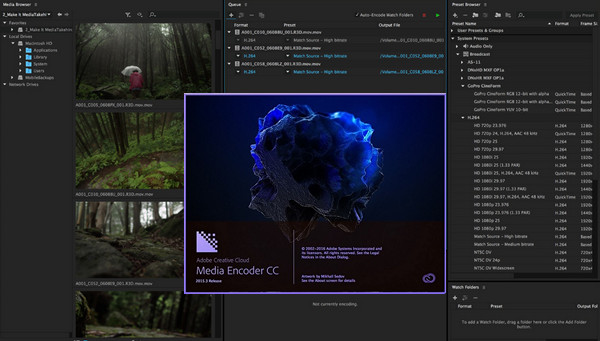
- #Adobe media encoder cc 2015.3 install
- #Adobe media encoder cc 2015.3 full
- #Adobe media encoder cc 2015.3 pro
- #Adobe media encoder cc 2015.3 code
If the file doesn’t exist, create it first. In the plugins folder, look for the appropriate blacklist file, and append the the filename of the plugin to the file (e.g. Note that this does not work for After Effects plugins loaded by AE, although it does work for AE plugins loaded in Premiere Pro. Specific plugins can be blocked from being loaded by MediaCore in specific applications, using blocklists. Plugin Blocklisting (formerly Blacklisting) ¶ ImporterSDK, FilterSDK, etc.) will help reduce user confusion. While it is not required for your plugin to load, naming your plugins using the plugin type as a prefix (e.g. Other supported plug-in standards use their conventional file extensions: “.aex” for After Effects plugins, “.dll” for VST plugins. On macOS, they have the file extension “.bundle”.
#Adobe media encoder cc 2015.3 pro
On Windows, Premiere Pro plugins must have the file extension “.prm”. Plugins//Effect Presets/ (see Localization for the list of language codes) Settings/EncoderPresets/SequencePreview//
#Adobe media encoder cc 2015.3 code
Library/Application Support/Adobe/Common/Plug-ins//MediaCore/įollowing OS X Code Signing guidelines, plugins should be installed in this separate shared location rather than in the application bundle.
#Adobe media encoder cc 2015.3 install
You’ll find at /Library/Preferences, which contains hints for your Mac installer to know where to install plugins, and is similar to the registry entries we have been providing on Win. Previously, starting in CC 2015, Premiere Pro provided installer hints for Mac.

Library/Application Support/Adobe/Common/Plugins/ControlSurface/ Library/Application Support/Adobe/Common/Plugins//MediaCore/ Starting in Premiere Pro version 22.0, The common plugin location is: Then, just add the proper subdirectories as described in the macOS section.

HKEY_LOCAL_MACHINE\SOFTWARE\Microsoft\Windows\CurrentVersion\App Paths\\ Adobe Premiere Pro.exe. The best way to locate other preset folders was to start from the root path for Premiere Pro in the registry at
#Adobe media encoder cc 2015.3 full
Value data: REG_SZ containing the full path of the plugin folder.Īs an example: C:\Program Files\Adobe\Common\Plugins\7.0\MediaCore\ HKEY_LOCAL_MACHINE/Software/Adobe/Premiere Pro/CurrentVersion Prior to CC, the only path given in the registry was the common plug-in path for the most recently installed version of Premiere Pro: Third-party installers can start from this path, and then modify the string to build the path to the language-specific effect presets. Value data: \Adobe Premiere Pro\Plugins\Common Value data: AppDataRoamingAdobeCommonAME7.0Presets\ Value data: \Settings\EncoderPresets\SequencePreview\


Library/Application Support/Adobe/Common/Plug-ins/ControlSurface/ Starting in CC 2015.3, control surface plugins should be installed here: Value data: C:\Program Files\Adobe\Common\Plugins\7.0\MediaCore\\ (or whatever the proper MediaCore plugins folder is note that this is the same as what the After Effects installer provides for a corresponding registry key) Key: HKEY_LOCAL_MACHINE/Software/Adobe/Premiere Pro/10.0/ Starting in CC, each version of Premiere Pro will create a unique registry key that provide locations of folders of interest for third-party installations for that version.įor example, here are the registry values for CC 2015.3: Premiere Pro will continue to attempt to load plugins from \Plug-Ins directories as well, for the foreseeable future. Other plugin types, such as QuickTime and VfW codecs should be installed at the operating system level.Īs of Premiere Pro version 22.0, the \Plug-ins directories have been renamed \Plugins, to better coincide with Apple’s Human Interface Guidelines. Supported Premiere and After Effects plugins installed here will be loaded by Premiere Pro, After Effects, Audition, and Media Encoder. Plugins should be installed in the common plugin location. It is also appreciated when an installer allows the user to specify an alternate directory. The installer should find the default installation directories as described below. This simplifies installation by the user, provides more compact distribution, and ensures all the pieces are installed correctly.Ĭreate a container folder for your plug-in(s) to minimize user confusion.ĭon’t unintentionally overwrite existing plugins, or replace newer versions. Plugin Blocklisting (formerly Blacklisting).


 0 kommentar(er)
0 kommentar(er)
